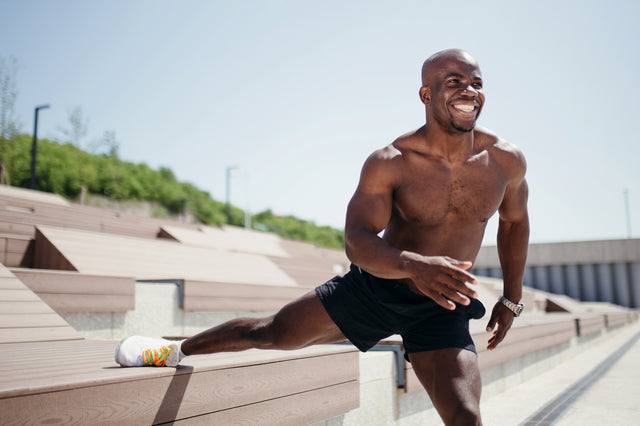You’re familiar with dieting, but what about reverse dieting? You know, the ‘diet after the diet’. The diet for when you’ve hit the weight loss plateau and have slashed calories down so far that your body stops responding to your efforts. It’s a frustrating place to be and trust us when we say we know this from first hand experience. This is why we’re going to teach you about reverse dieting and how to successfully reverse diet your way back to a healthy, happy body.
What Is A Reverse Diet
Until more recently, reverse dieting was really a term coined by the bodybuilding industry to help competitors after they did a show. Since you have to cut, cut, and cut calories completely to get the body to a stage ready presence, you can’t just go back to eating normally right when you get off stage. You have to ease the body back into handling food, calories, and function with small increases in calories. More recently, reverse dieting has become popular in everyday weight loss enthusiasts thanks to popular fad diets that severely restrict calories, resulting in the metabolism halting/slowing function and leading to the dreaded weight loss plateau.
Unlike a traditional diet where you cut calories, a reverse diet is just that, a reverse of the calories in the upward direction. By increasing the calories slowly and steadily, you’re not only able to eat more food (who wouldn’t want that) but you’re also able to improve your metabolic functioning while reducing your waistline.
RELATED: Do Increased Testosterone Levels Help Reduce Body Fat
How Does Reverse Dieting Work
Reverse dieting works in the body to restore the body’s metabolic function to use the calories from your food efficiently to optimize body composition and overall health. Unfortunately though, it isn’t as simple as calories in, calories out (CICO). In this energy balance theory, it is thought that when you eat more calories than you burn, you will gain weight. And the opposite, when you eat less calories than you burn, you lose weight.
However, there are many things that affect how our bodies use calories and energy from food, which further complicates weight loss and body optimization (like genetics, appetite, activity, stress, sleep, etc.). This is where your metabolism comes into play. Before we can fully understand why reverse dieting can work, we must understand how the metabolism works.
RELATED: How Sleep Affects Metabolism, Body Composition, and Overall Health
What Is Metabolic Adaptation
Our metabolism adapts to the amount of food we eat (or don’t eat, like if we’re dieting) to use those calories efficiently. Unfortunately, organ function is more important than cutting body fat for aesthetics, so when we cut calories thanks to our fad diet, our metabolism can actually slow down and actually end up halting weight loss or gaining weight in the way of body fat.
Our metabolisms are highly adaptive and extremely functional when it comes to keeping us alive and using our food intake to support our bodily function. From keeping our organs running efficiently, to building muscle, and to supporting daily activity, every ounce of energy that we have comes from the processes that happen in our metabolism. Reverse dieting works thanks to something called adaptive thermogenesis or in a more lay term, metabolic adaptation.
RELATED: 7 Delicious Oatmeal Recipes To Boost Your Metabolism
What Happens When Weight Loss Slows Or Halts
When your metabolism adapts to the low calorie intake there are quite a few different things that happen.
-
Repressed Hormone Function: The hunger hormones (leptin, ghrelin, insulin, peptide YY) may not function efficiently driving you to feel like you’re always hungry, not satiated, and you may actually end up eating more on a regular basis contributing to weight gain
-
Reduced exercise activity thermogenesis (EAT): This results in significant decreases in performance in activities in and out of the gym and in turn surpasses the calorie burning process that you experience when you exercise
-
Slowed Digestion: Since the body ins’t getting very much food, your digestion can slow so that the body has the best ability to suck out every ounce of nutrients and calories from your food to support overall health and function
-
Reduced thermic effect of food (TEF): You’ll burn less calories from digesting your food and the process of digestion through the GI tract
- Reduced resting metabolic rate (RMR): When your not feeding your body sufficiently your vital organs will be more important for your metabolism to give energy to as compared to other functions like reducing inflammation, building/repairing muscle tissue, or supporting hair and nail health
The good news here is that with reverse dieting and slowly increasing the amount of calories your body has to use for bodily functions, you can soothe the body back into running metabolic functions efficiently and healthily. This will not only reverse all the aforementioned effects of a slowed metabolism, but support overall energy, vibrancy, and in the long term, your weight loss abilities.
RELATED: 6 Thermogenic Foods That Can Boost Your Metabolism
Why Do People Gain Weight After Dieting
Most diets fail and most people gain back the weight they lost within 6 months of stopping their diet. Typically speaking, most people who severely restrict calories from a fad diet, like keto or Atkins, will go back to their old ways of eating, jumping calorie intake way too quickly, and gaining weight. Overeating, celebrating weight loss with food, and consuming all those foods that your diet said you couldn’t have and that were off limits (bread, fruit, candy, dairy, etc.) can also negatively contribute to weight gain. Another reason why this happens is because diets don’t teach you how to create a lifestyle around your weight loss and new weight management, which is a major pitfall of dieting, and where reverse dieting can really shine.
RECOMMENDED: THERM - natural thermogenic fat burning supplement
Who Should Reverse Diet
If you’re familiar with dieting, yo-yo dieting, and severely restricting calories for an extended period of time, or if you’ve experienced a significant weight loss plateau, then coming out of this caloric deficit can be a prime opportunity to work on reverse dieting. In doing so, you’ll be able to gradually increase calories, eat more food, improve metabolic function, and feel better overall.
It is important to note that reverse dieting isn’t to lose weight in the short term, but to be able to get your body back to a place where when you do decide to do a cut or enter into a weight loss journey, you can do so without restricting your body to such low numbers. Another great position to perform a reverse diet is if your performance/activity has been outweighing your calorie/food intake and you’ve hit a plateau with your performance, strength gains, and overall function.
When you reverse diet, you can expect to see increases in your basal metabolic rate (BMR) and your calorie expenditure, your workout capacity will significantly increase because you’ll have more readily available energy, your digestion improves resulting in better absorption of nutrients and better bowel movements, your hormone function will improve and you’ll get those feelings of hunger and fullness on a more regular basis, bloating will decrease, skin, hair, and nail quality will increase, and many other things. Cool, right? We think so.
RELATED: Why Personalized Nutrition Works Better Than Traditional Diets
How To Reverse Diet
So you’ve gotten this far, and you’ve decided that you’ve been in a calorie deficit for too long and that traditional diets are no longer for you. Let’s say that you recognize that reverse dieting isn’t magic and that the goal is not to lose weight during this process, but rather to get the body back to optimal function, so that the next time you want to reduce weight, you can successfully and without severely restricting yourself. Okay, we’re in a good position! Let’s dig into how to reverse diet and what that reverse dieting landscape looks like for you.
Reverse Diet Plan
Step 1: Track your food intake
You need to know your calorie intake so that you can understand how to gradually increase your calories over time. you can track your food with counting macros, logging in an app like My Fitness Pal, or using hand portions. You can also hire a nutrition coach to calculate your numbers and lead you on your journey of how to reverse diet (this will be the most efficient way).
Schedule Your Free Nutrition Consult Here
Step 2: Calculate Calories
You need to know what your maintenance calories are to maintain your body and weight the way it is right now. If you need a handy little calorie calculator, you can find that here for free and it gives you instant results.
Step 3: Determine your Macros
After you find your calories, you have a general idea of how many calories it takes on a daily basis to maintain your current weight. Now you’ll want to find out your macros that make up those calories in the way of protein, carbs, and fats. We also have a calculator for that here that gives you instant results for free.
RELATED: 6 Ways To Get More Protein Into Your Diet
Step 4: Identify your goal
Reverse dieting takes time and it is encouraged to be patient with the process. The faster you do it the more likely you are to gain body fat, so if you want to use that as motivation to take it slow and respect the process, then by all means please do so. We recommend setting a goal of 2-3 months to successfully reverse diet. Again, having a coach can really help during this process and we greatly encourage considering working with a nutritionist.
Schedule Your Free Nutrition Consult Here
Step 5: Add Calories
Now it is time to slowly add in calories. We recommend bumping calories on your carbs and fat (your protein macro should be anywhere between 0.8 - 1.2g / lb body weight) once a week or every 7 days. For example, we recommend a 4-5% calories increase, or 100-300 calorie increase per week.
Step 6: Track Your Progress
Make sure to log your calories, macros, and your food in an app or a journal. Be precise, be diligent, and be dedicated to the process. In doing so, track your progress. Take progress photos, measurements, and monitor the way that your body responds. Are you gaining weight too fast? Slow down the 7-day calorie bumps. Are you leaning out, responding well, reducing bloating and increasing energy? Then you’re probably spot on and just need to stay consistent. This is a trial and error process when finding your rhythm, and do remember, a coach can make this process a lot easier and be able to not only keep you accountable but motivated along the way.
Schedule Your Free Nutrition Consult Here
When To Stop Reverse Dieting
Like we mentioned, a little weight gain shouldn’t be anything to worry about and is completely normal when reverse dieting and getting the body back to a place where it has a sufficient amount of calories/energy to do what it needs to do. The weight might fluctuate, and this is okay too. You might gain one week, lose another week, and so on. The weight fluctuation might be anywhere from 2-10 lbs and this is okay, too.
However, if you get to a point where you’re gaining more than that and your weight isn’t stabilizing, this may be an indication that it is time to slow the calorie increase and maintain. You eventually will reach a place where you’re eating over your new maintenance calorie intake and this is where you’ll want to pause on the calorie intake.
“Here at The Swole Kitchen when we take a client through a reverse diet, the client can feel uneasy and unsure about the process, which is completely understandable. We help our clients understand the process, what to look for, how to measure progress, and how to feel confident and comfortable through the process of reverse dieting. We know when a client is ready to end their reverse diet when weight gain has become linear and the macros are stable. When this happens, we stop increasing calories and revisit the client’s goals and progress to determine where to go from here. It’s an intimate process and we love empowering individuals to recognize that they don’t need to live in severe calorie restriction, that they can enjoy food, eat food, and love the body that they’re in!”
— Coach Jocelyn, The Swole Kitchen Nutritionist
How To Reverse Diet Takeaway
Reverse dieting is a great way to step away from caloric restriction to soothe the body back into being able to lose weight, break through weight loss plateaus, and to improve overall function. From hormones, to energy, to digestion, bloating, and athletic performance, by slowly increasing calories over time, you can improve metabolic adaption. Yes, you may gain a little weight when you reverse diet, and the maintenance phase after a reverse diet can be a few months, but the benefits that your body will reap are boundless. However, embarking on a reverse diet journey on your own can be daunting, and that is why we highly recommend working 1:1 with a nutritionist to achieve the most efficient and optimal results from your efforts.
Need Help With Optimizing Your Diet And Nutrition Plan To Finally Get The Results You've Been Waiting For?

SWOLVERINE IS AN ENDURANCE ATHLETE AND ACTIVE LIFESTYLE BRAND. MADE FOR THE ELITE ATHLETE, AND THE STRONG-WILLED OUR PRODUCTS WERE DESIGNED TO FUEL YOUR ATHLETIC PERFORMANCE. WE PERFORM WHEN YOU PERFORM.
We believe that everyone can optimize not only their athletic performance but their human potential. The way we believe we can optimize performance is through transparency, clinically effective doses, and clinically proven ingredients with evidence-based outcomes. We provide the nutrients you need to power your active lifestyle.







